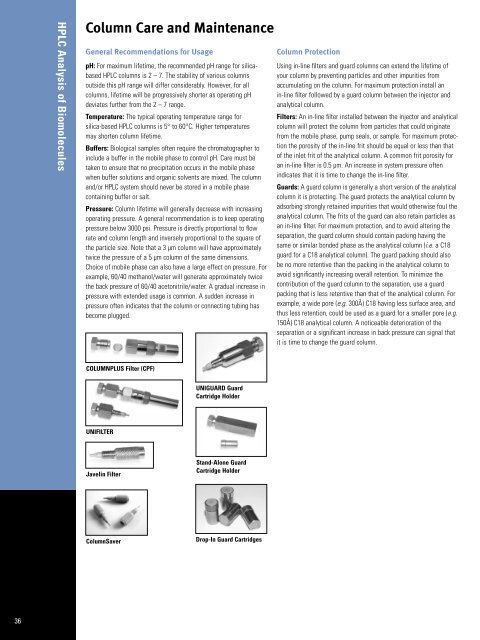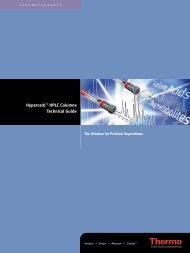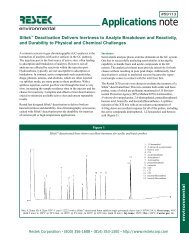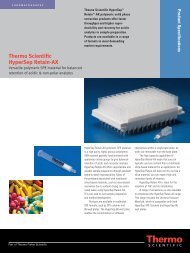HPLC Analysis of Biomolecules Technical Guide - Interscience
HPLC Analysis of Biomolecules Technical Guide - Interscience
HPLC Analysis of Biomolecules Technical Guide - Interscience
You also want an ePaper? Increase the reach of your titles
YUMPU automatically turns print PDFs into web optimized ePapers that Google loves.
36<br />
<strong>HPLC</strong> <strong>Analysis</strong> <strong>of</strong> <strong>Biomolecules</strong><br />
Column Care and Maintenance<br />
General Recommendations for Usage<br />
pH: For maximum lifetime, the recommended pH range for silicabased<br />
<strong>HPLC</strong> columns is 2 – 7. The stability <strong>of</strong> various columns<br />
outside this pH range will differ considerably. However, for all<br />
columns, lifetime will be progressively shorter as operating pH<br />
deviates further from the 2 – 7 range.<br />
Temperature: The typical operating temperature range for<br />
silica-based <strong>HPLC</strong> columns is 5° to 60°C. Higher temperatures<br />
may shorten column lifetime.<br />
Buffers: Biological samples <strong>of</strong>ten require the chromatographer to<br />
include a buffer in the mobile phase to control pH. Care must be<br />
taken to ensure that no precipitation occurs in the mobile phase<br />
when buffer solutions and organic solvents are mixed. The column<br />
and/or <strong>HPLC</strong> system should never be stored in a mobile phase<br />
containing buffer or salt.<br />
Pressure: Column lifetime will generally decrease with increasing<br />
operating pressure. A general recommendation is to keep operating<br />
pressure below 3000 psi. Pressure is directly proportional to flow<br />
rate and column length and inversely proportional to the square <strong>of</strong><br />
the particle size. Note that a 3 µm column will have approximately<br />
twice the pressure <strong>of</strong> a 5 µm column <strong>of</strong> the same dimensions.<br />
Choice <strong>of</strong> mobile phase can also have a large effect on pressure. For<br />
example, 60/40 methanol/water will generate approximately twice<br />
the back pressure <strong>of</strong> 60/40 acetonitrile/water. A gradual increase in<br />
pressure with extended usage is common. A sudden increase in<br />
pressure <strong>of</strong>ten indicates that the column or connecting tubing has<br />
become plugged.<br />
COLUMNPLUS Filter (CPF)<br />
UNIFILTER<br />
Javelin Filter<br />
ColumnSaver<br />
UNIGUARD Guard<br />
Cartridge Holder<br />
Stand-Alone Guard<br />
Cartridge Holder<br />
Drop-In Guard Cartridges<br />
Column Protection<br />
Using in-line filters and guard columns can extend the lifetime <strong>of</strong><br />
your column by preventing particles and other impurities from<br />
accumulating on the column. For maximum protection install an<br />
in-line filter followed by a guard column between the injector and<br />
analytical column.<br />
Filters: An in-line filter installed between the injector and analytical<br />
column will protect the column from particles that could originate<br />
from the mobile phase, pump seals, or sample. For maximum protection<br />
the porosity <strong>of</strong> the in-line frit should be equal or less than that<br />
<strong>of</strong> the inlet frit <strong>of</strong> the analytical column. A common frit porosity for<br />
an in-line filter is 0.5 µm. An increase in system pressure <strong>of</strong>ten<br />
indicates that it is time to change the in-line filter.<br />
Guards: A guard column is generally a short version <strong>of</strong> the analytical<br />
column it is protecting. The guard protects the analytical column by<br />
adsorbing strongly retained impurities that would otherwise foul the<br />
analytical column. The frits <strong>of</strong> the guard can also retain particles as<br />
an in-line filter. For maximum protection, and to avoid altering the<br />
separation, the guard column should contain packing having the<br />
same or similar bonded phase as the analytical column (i.e. a C18<br />
guard for a C18 analytical column). The guard packing should also<br />
be no more retentive than the packing in the analytical column to<br />
avoid significantly increasing overall retention. To minimize the<br />
contribution <strong>of</strong> the guard column to the separation, use a guard<br />
packing that is less retentive than that <strong>of</strong> the analytical column. For<br />
example, a wide pore (e.g. 300Å) C18 having less surface area, and<br />
thus less retention, could be used as a guard for a smaller pore (e.g.<br />
150Å) C18 analytical column. A noticeable deterioration <strong>of</strong> the<br />
separation or a significant increase in back pressure can signal that<br />
it is time to change the guard column.





